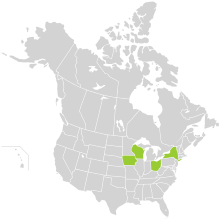This article needs additional citations for verification. (May 2020) |
| Northern wild monkshood | |
|---|---|

| |
| Scientific classification | |
| Kingdom: | Plantae |
| Clade: | Tracheophytes |
| Clade: | Angiosperms |
| Clade: | Eudicots |
| Order: | Ranunculales |
| Family: | Ranunculaceae |
| Genus: | Aconitum |
| Species: | A. noveboracense
|
| Binomial name | |
| Aconitum noveboracense | |

| |
Aconitum noveboracense, also known as northern blue monkshood or northern wild monkshood, is a flowering plant belonging to the buttercup family (Ranunculaceae). Members of its genus (Aconitum) are also known as wolfsbane.
The United States Fish and Wildlife Service government lists it as a threatened species.[2][3][4] It grows in rare portions of New York State and in portions of the Driftless Area.
Northern monkshood is noted for its very distinctive, blue hood-shaped flowers. The flowers are about 1 inch (2.5 cm) in length, and a single stem may have many flowers. Stems range from about 1 to 4 feet (0.30 to 1.22 m) in length. The leaves are broad with coarse, toothed lobes.
- Only found in Iowa, Wisconsin, Ohio, and New York.
- Typically found on shaded to partially shaded cliffs, algific talus slopes, or on cool, streamside sites. These areas have cool soil conditions, cold air drainage, or cold groundwater flowage. On algific talus slopes, these conditions are caused by the outflow of cool air and water from ice contained in underground fissures. These fissures are connected to sinkholes and are a conduit for the air flows.
Northern monkshood is a perennial and reproduces from both seed and small tubers. The flowers bloom between June and September and are pollinated when bumblebees pry open the blossom to collect nectar and pollen.
- ^ NatureServe (7 April 2023). "Aconitum noveboracense". NatureServe Network Biodiversity Location Data accessed through NatureServe Explorer. Arlington, Virginia: NatureServe. Retrieved 23 April 2023.
- ^ a b "Northern wild monkshood (Aconitum noveboracense)". Environmental Conservation Online System. U.S. Fish & Wildlife Service. Retrieved 23 April 2023.
- ^ a b 43 FR 17910
- ^ "Species Profile for Northern wild monkshood". Archived from the original on 15 February 2005. Retrieved 8 August 2005.

